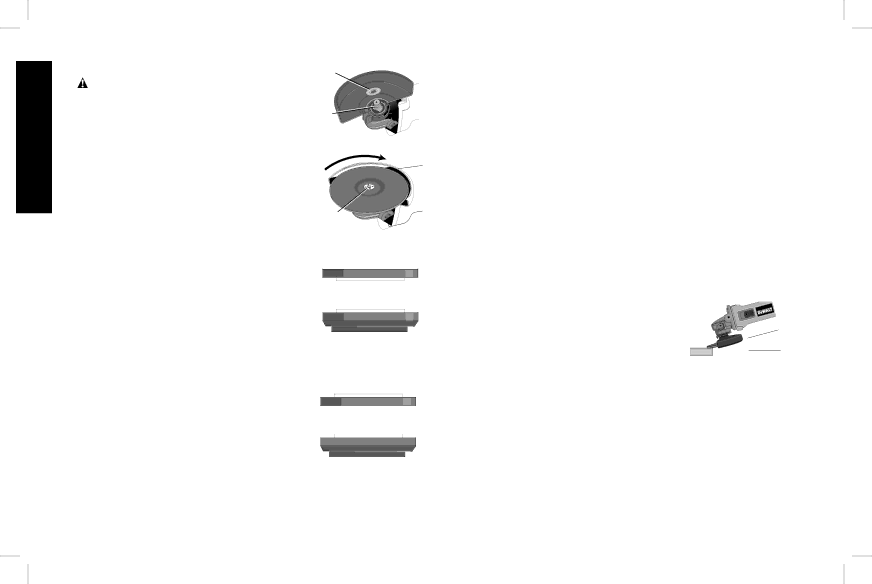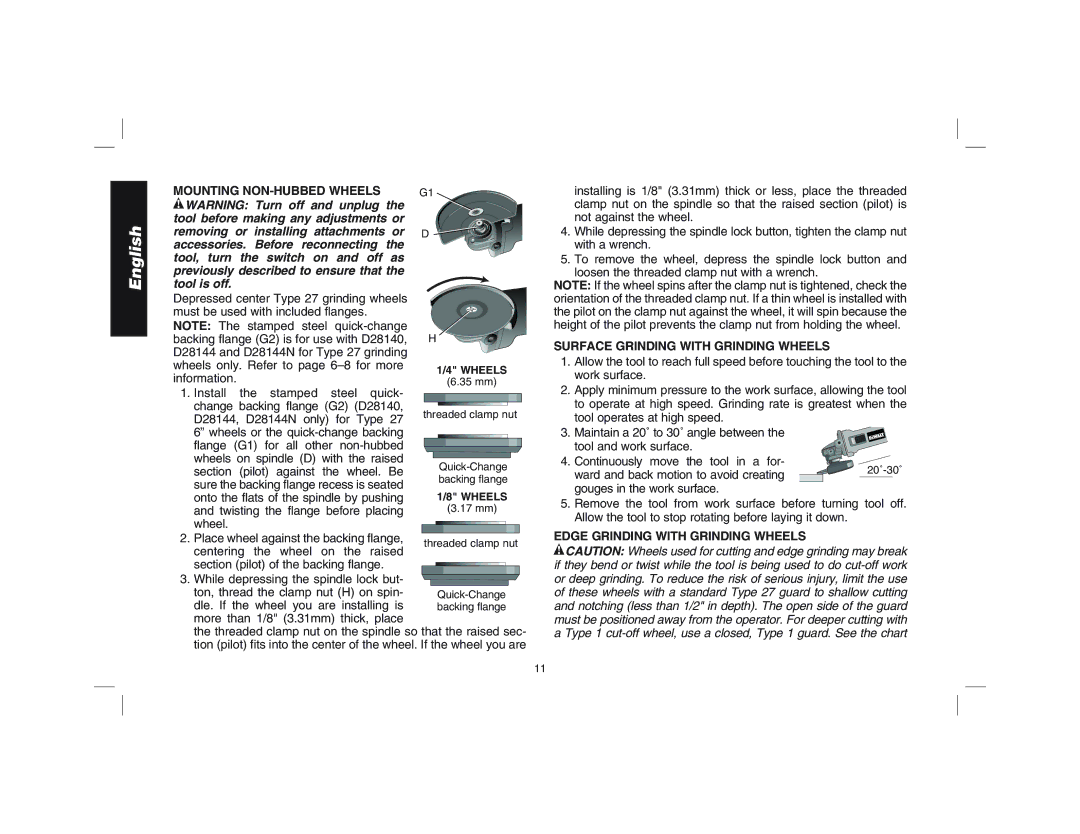
English
MOUNTING | G1 | ||||
WARNING: Turn off and unplug the |
| ||||
tool before making any adjustments or |
| ||||
removing or installing attachments or | D | ||||
accessories. Before reconnecting the |
| ||||
tool, turn the switch on and off as |
| ||||
previously described to ensure that the |
| ||||
tool is off. |
|
|
|
| |
Depressed center Type 27 grinding wheels |
| ||||
must be used with included flanges. |
| ||||
NOTE: The stamped steel |
| ||||
backing flange (G2) is for use with D28140, | H | ||||
D28144 and D28144N for Type 27 grinding |
| ||||
wheels only. Refer to page | 1/4" WHEELS | ||||
information. |
|
|
| ||
|
|
| (6.35 mm) | ||
1. Install | the | stamped | steel quick- |
| |
change backing flange (G2) (D28140, | threaded clamp nut | ||||
D28144, D28144N only) for Type 27 | |||||
| |||||
6” wheels or the |
| ||||
flange (G1) for all other |
| ||||
wheels on spindle (D) with the raised | |||||
section | (pilot) | against | the wheel. Be | ||
backing flange | |||||
sure the backing flange recess is seated | |||||
1/8" WHEELS | |||||
onto the flats of the spindle by pushing | |||||
and twisting the flange before placing | (3.17 mm) | ||||
wheel. |
|
|
|
| |
2. Place wheel against the backing flange, | threaded clamp nut | |||||
centering the wheel on the raised | ||||||
|
|
|
|
| ||
section (pilot) of the backing flange. |
|
|
|
|
| |
|
|
|
|
| ||
|
|
|
|
| ||
|
|
|
|
|
| |
3. While depressing the spindle lock but- ton, thread the clamp nut (H) on spin-
dle. If the wheel you are installing is more than 1/8" (3.31mm) thick, place
the threaded clamp nut on the spindle so that the raised sec- tion (pilot) fits into the center of the wheel. If the wheel you are
installing is 1/8" (3.31mm) thick or less, place the threaded clamp nut on the spindle so that the raised section (pilot) is not against the wheel.
4.While depressing the spindle lock button, tighten the clamp nut with a wrench.
5.To remove the wheel, depress the spindle lock button and loosen the threaded clamp nut with a wrench.
NOTE: If the wheel spins after the clamp nut is tightened, check the orientation of the threaded clamp nut. If a thin wheel is installed with the pilot on the clamp nut against the wheel, it will spin because the height of the pilot prevents the clamp nut from holding the wheel.
SURFACE GRINDING WITH GRINDING WHEELS
1.Allow the tool to reach full speed before touching the tool to the work surface.
2.Apply minimum pressure to the work surface, allowing the tool to operate at high speed. Grinding rate is greatest when the tool operates at high speed.
3. Maintain a 20˚ to 30˚ angle between the tool and work surface.
4. Continuously move the tool in a for- ward and back motion to avoid creating gouges in the work surface.
5.Remove the tool from work surface before turning tool off. Allow the tool to stop rotating before laying it down.
EDGE GRINDING WITH GRINDING WHEELS
![]() CAUTION: Wheels used for cutting and edge grinding may break if they bend or twist while the tool is being used to do
CAUTION: Wheels used for cutting and edge grinding may break if they bend or twist while the tool is being used to do
11
